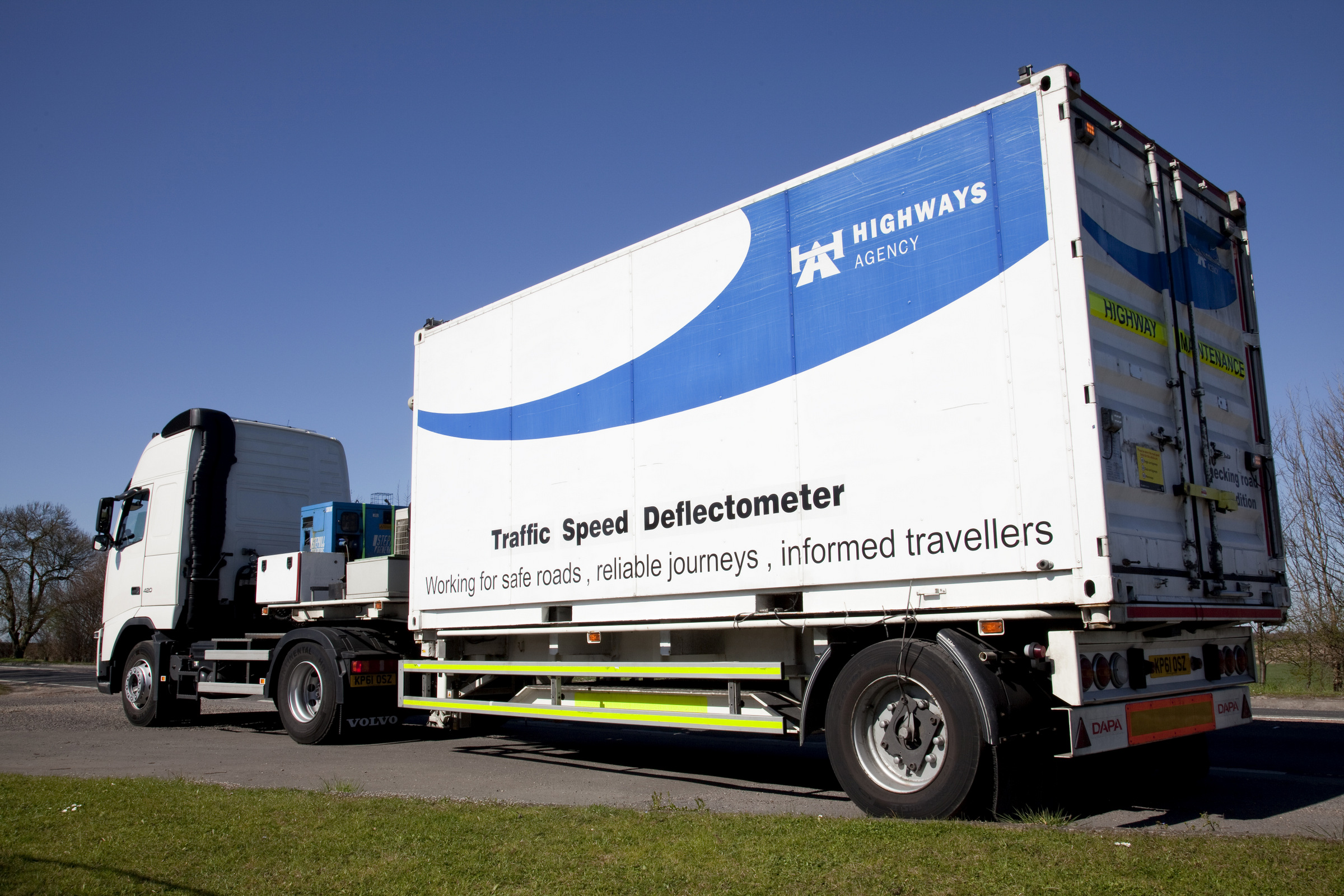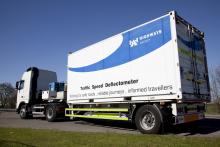The United Kingdom’s Highways Agency has awarded its first commercial contract to survey thousands of road lanes using sophisticated Doppler laser equipment. Fugro is driving the project forward, reports David Arminas
The Highways Agency Traffic Speed Defelectometer vehicle looks like an ordinary flatbed truck delivering a similarly ordinary steel shipping container. But looks are deceiving. Inside the container is a sophisticated Doppler laser measuring system collecting pavement condition data of the U

The Highways Agency’s Traffic Speed Deflectometer
The United Kingdom’s Highways Agency has awarded its first commercial contract to survey thousands of road lanes using sophisticated Doppler laser equipment. Fugro is driving the project forward, reports David Arminas
The2309 Highways Agency Traffic Speed Defelectometer vehicle looks like an ordinary flatbed truck delivering a similarly ordinary steel shipping container. But looks are deceiving. Inside the container is a sophisticated Doppler laser measuring system collecting pavement condition data of the United Kingdom’s trunk roads. Under a three-year contract recently signed with engineering firm 6202 Fugro, the truck has set about driving thousands of kilometres of lanes and associated slip roads. It’s the latest step in the agency’s move to set up a preventative maintenance strategy.
Fugro, a listed global company based in Cambridge, UK, interprets earth and engineering data for the design, construction and maintenance of major projects, mostly in the offshore and onshore energy and infrastructure markets. The US$2 million (£1.3 million) three-year contract is the result of successful trials over two years.
The company, which specialises in acquiring and interpreting earth and engineering data, worked closely with the UK’s Transport Research Laboratory that developed the Traffic Speed Defelectometer vehicle (TSD) for the agency.
The contract award was the culmination of developmental trials since 2009 of the TSD by the Transport Research Laboratory for the agency. The agency commissioned trials which were conducted by three companies, including Fugro, in 2011 and 2012. Fugro surveyed 5,600 lane kms of English trunk roads and processed data overnight for evaluation by the agency.
It was earlier, in 2006, when the agency purchased the truck and a shipping container in which it installed traffic speed deflector technology, explains Roger Fairclough, a senior Highways Agency pavement engineer with responsibility for the TSD vehicle.
The Doppler laser equipment measures pavement deflections in response to the truck’s load, says Fairclough, a civil engineer who has been with the Highways Agency since 2002.
The agency contracted the Transport Research Laboratory -- an independent transport research, consultancy, tester and certifier – to run the TSD and upgrade the deflector technology that the agency had purchased from2283 Greenwood Engineering, based in Brondby, Denmark. Greenwood, a small company with 40 employees, manufactures measuring equipment for monitoring and condition surveys in the road and railway sectors.
777 TRL also designed the data processing and analysis algorithms required for TSD data to be embedded within the agency’s Pavement Management System (HAPMS).
After analysis of the data, the strength and condition of each 100m of road is categorised as in Network Structural Condition (NSC) 1 to 4, explains Fairclough. Pavement with an NSC1 category is structurally sound, meaning no work is needed. NSC2 may need minor work and pavement in NSC4 is considered to be suffering from potentially severe structural deterioration.
As part of the agency’s strategy to commercialise the process – the agency outsources the vast majority of its work – several companies, one being Fugro, were contracted to separately run the vehicle on a test basis. The companies got paid an up-front amount and then more money based on the quality of data collected, says Fairclough.
The Transport Research Laboratory worked closely with the contractors as they drove over more than 21,000km of lanes taking over 1,000 million deflection data points.
Under the contract eventually signed with Fugro, Fairclough estimates that around 14,000km of what the agency calls Lane 1 pavement can be monitored in about two months. Because the TSD drives at 80kph, it contributes little towards traffic congestion, explains Fairclough.
“This is 30 times faster than before, where the process needed lane and entire road closures for men to physically walk the equipment around,” he said. This also means less risk of accidents to subcontractors because there is no need for road closures.
The agency categorises lanes from Lane 0 – the hard shoulder of a road – followed by Lane 1, then next in towards to the centre is Lane 2 and so on to category 4. It’s this Lane 1, the so-called slow lane, that on motorways is the one most damaged by road users, largely by heavy goods vehicles.
Construction records held centrally within HAPMS have not always been up to date. Knowledge of the thickness and the materials of the underlying road structure is key to understanding the measurements provided by the TSD. But it has to be remembered that Doppler measurements are not an indication of subsurface quality. They determine road surface condition which is an indicator at best of possible subsurface deterioration, although a very good indicator all the same, says Fairclough.
Under the agency’s contract with Fugro, the company is taking over the running and maintenance of the vehicle and will ensure that data collected is robust. Fugro supplies a driver and an operator who rides in the truck cab. TRL remains the software troubleshooter and is available by phone should there be a software issue. Fugro plans the vehicle’s routes and ensures it is in a secure compound in the evenings, says Fugro’s business development manager Mark Thomas, an exploration geologist with more than 10 years’ experience in the road and rail sector.
Fugro maintains the laser hardware, essential for ensuring that data remains robust, says Thomas. During the past summer, the TSD was operating sometimes 24 hours a day, trundling around England’s trunk roads. That was possible because the weather was usually dry, meaning pavements were also dry, an important factor for capturing useable data, he says.
The issue of robust data – consistent quality – is paramount, explains Simon Brightwell, Fugro’s geophysics marketing manager for the Africa-Caspian-Europe region. “What we do on one day, has to be replicated on the next day, and the next, and so on,” says Brightwell, a trained environmental scientist, also with more than a decade’s experience.
Fugro conducts tests every day to make sure the laser machine is operating to its optimal performance, meaning data can be confidently compared. Data is acquired, stored, processed and sent to the agency’s HAPMS for analysis.
To explore what lies under the pavement, Fugro will incorporate a ground-penetrating radar (GPR) system into the TSD vehicle, probably by the end of next year says Brightwell. Much experience on operating a GPR system is being gained right now under a contract with the US state of California where Fugro is involved in a three-year structural inventory survey of 83,000km of roads. That contract requires daily repeat runs or secondary site checks to ensure data repeatability, a weekly primary site check and monthly accreditation of hardware and operators.
Fugro’s European road infrastructure work also includes a Dutch project. Fugro is detecting and mapping the presence of potentially harmful heavy metal residues from industrial by-products in rural roads throughout the De Kempen region.
The
Fugro, a listed global company based in Cambridge, UK, interprets earth and engineering data for the design, construction and maintenance of major projects, mostly in the offshore and onshore energy and infrastructure markets. The US$2 million (£1.3 million) three-year contract is the result of successful trials over two years.
The company, which specialises in acquiring and interpreting earth and engineering data, worked closely with the UK’s Transport Research Laboratory that developed the Traffic Speed Defelectometer vehicle (TSD) for the agency.
The contract award was the culmination of developmental trials since 2009 of the TSD by the Transport Research Laboratory for the agency. The agency commissioned trials which were conducted by three companies, including Fugro, in 2011 and 2012. Fugro surveyed 5,600 lane kms of English trunk roads and processed data overnight for evaluation by the agency.
It was earlier, in 2006, when the agency purchased the truck and a shipping container in which it installed traffic speed deflector technology, explains Roger Fairclough, a senior Highways Agency pavement engineer with responsibility for the TSD vehicle.
The Doppler laser equipment measures pavement deflections in response to the truck’s load, says Fairclough, a civil engineer who has been with the Highways Agency since 2002.
The agency contracted the Transport Research Laboratory -- an independent transport research, consultancy, tester and certifier – to run the TSD and upgrade the deflector technology that the agency had purchased from
After analysis of the data, the strength and condition of each 100m of road is categorised as in Network Structural Condition (NSC) 1 to 4, explains Fairclough. Pavement with an NSC1 category is structurally sound, meaning no work is needed. NSC2 may need minor work and pavement in NSC4 is considered to be suffering from potentially severe structural deterioration.
As part of the agency’s strategy to commercialise the process – the agency outsources the vast majority of its work – several companies, one being Fugro, were contracted to separately run the vehicle on a test basis. The companies got paid an up-front amount and then more money based on the quality of data collected, says Fairclough.
The Transport Research Laboratory worked closely with the contractors as they drove over more than 21,000km of lanes taking over 1,000 million deflection data points.
Under the contract eventually signed with Fugro, Fairclough estimates that around 14,000km of what the agency calls Lane 1 pavement can be monitored in about two months. Because the TSD drives at 80kph, it contributes little towards traffic congestion, explains Fairclough.
“This is 30 times faster than before, where the process needed lane and entire road closures for men to physically walk the equipment around,” he said. This also means less risk of accidents to subcontractors because there is no need for road closures.
The agency categorises lanes from Lane 0 – the hard shoulder of a road – followed by Lane 1, then next in towards to the centre is Lane 2 and so on to category 4. It’s this Lane 1, the so-called slow lane, that on motorways is the one most damaged by road users, largely by heavy goods vehicles.
Construction records held centrally within HAPMS have not always been up to date. Knowledge of the thickness and the materials of the underlying road structure is key to understanding the measurements provided by the TSD. But it has to be remembered that Doppler measurements are not an indication of subsurface quality. They determine road surface condition which is an indicator at best of possible subsurface deterioration, although a very good indicator all the same, says Fairclough.
Under the agency’s contract with Fugro, the company is taking over the running and maintenance of the vehicle and will ensure that data collected is robust. Fugro supplies a driver and an operator who rides in the truck cab. TRL remains the software troubleshooter and is available by phone should there be a software issue. Fugro plans the vehicle’s routes and ensures it is in a secure compound in the evenings, says Fugro’s business development manager Mark Thomas, an exploration geologist with more than 10 years’ experience in the road and rail sector.
Fugro maintains the laser hardware, essential for ensuring that data remains robust, says Thomas. During the past summer, the TSD was operating sometimes 24 hours a day, trundling around England’s trunk roads. That was possible because the weather was usually dry, meaning pavements were also dry, an important factor for capturing useable data, he says.
The issue of robust data – consistent quality – is paramount, explains Simon Brightwell, Fugro’s geophysics marketing manager for the Africa-Caspian-Europe region. “What we do on one day, has to be replicated on the next day, and the next, and so on,” says Brightwell, a trained environmental scientist, also with more than a decade’s experience.
Fugro conducts tests every day to make sure the laser machine is operating to its optimal performance, meaning data can be confidently compared. Data is acquired, stored, processed and sent to the agency’s HAPMS for analysis.
To explore what lies under the pavement, Fugro will incorporate a ground-penetrating radar (GPR) system into the TSD vehicle, probably by the end of next year says Brightwell. Much experience on operating a GPR system is being gained right now under a contract with the US state of California where Fugro is involved in a three-year structural inventory survey of 83,000km of roads. That contract requires daily repeat runs or secondary site checks to ensure data repeatability, a weekly primary site check and monthly accreditation of hardware and operators.
Fugro’s European road infrastructure work also includes a Dutch project. Fugro is detecting and mapping the presence of potentially harmful heavy metal residues from industrial by-products in rural roads throughout the De Kempen region.







